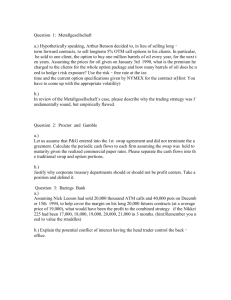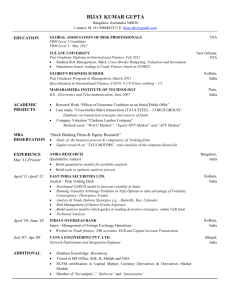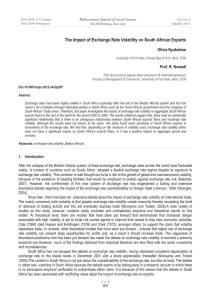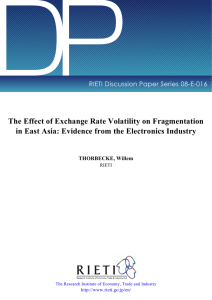The Effect of Exchange Rate Volatility on the
advertisement
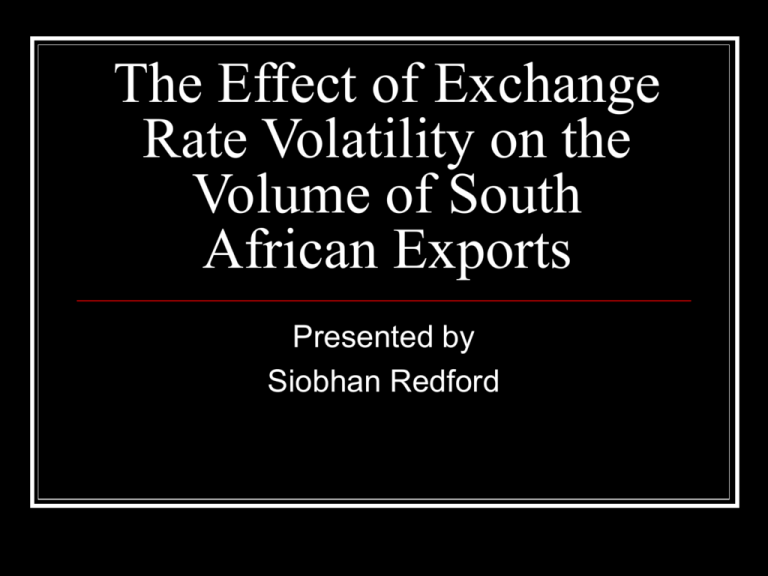
The Effect of Exchange Rate Volatility on the Volume of South African Exports Presented by Siobhan Redford Disclaimer The views expressed are those of the authors and do not necessarily represent those of the South African Reserve Bank or Reserve Bank policy. While every precaution is taken to ensure the accuracy of information, the South African Reserve Bank shall not be liable to any person for inaccurate information or opinions contained herein. Introduction Exports identified as an important economic growth area for developing countries. Exchange Rate volatility, it has been suggested, has a negative effect on export volumes. The ASGISA document suggests that this is the case for South Africa. Theoretical Motivation Motivation for most producers to enter a market is to earn a return on investment. Most firms do this through profit maximising behaviour. Profit = F(Total revenue; Total cost of sales) Total Revenue is dependent on the price of the good sold exchange rate volatility could lead to uncertainty of this price for exported goods. Theoretical Motivation Cont. A typical profit function is given by: PQ( x) W ( x) Where PQ(x) would have to be split up such that PQ( x) t (e, v)ep * Q( x) (1 t (e, v)) pQ( x) e is the presiding exchange rate Q(x) is the number of produced goods available p* is the foreign price of goods, p is the local price t(e,v) is the proportion of produced goods sent for export, variable in the level of the exchange rate and the variablility of the exchange rate. Theoretical Literature Bigman and Leite (1978) De Grauwe (1988) Melitz (2003) Arize et al (2000) Caballero & Corbo (1989) Evidence from the rest of the world and South Africa Methodological Arguments Modelling Considerations Arize(1997) Antle (1983) Hooper and Kohlhagen (1978) Kenen and Rodrik (1986) Caballero and Carbo (1989) Chowdhury (1993) Kroner and Lastrapes (1993) Arize et al (2000) South African Evidence Todani and Munyama (2005) Wilcox (2007) Data Data taken from SARB, REER a construct using SARB weights. Quarterly Data from 1961Q1 to 2007Q1 Construction of the exchange rate volatility variable: Moving average standard deviation Conditional variance of the exchange rate (GARCH(5;0)) Stationarity ADF tests suggest that all variables are I(1) except the volatility variables which do not return any conclusive evidence. The problem with the volatility variables: Seem to have a stationary mean (this is what most stationarity tests test for), do not have a stationary variation. Variance of exchange rate Plot of Residuals and Two Standard Error Bands 0.25 HV 0.20 HV LV LV 0.15 0.10 0.05 0.00 -0.05 -0.10 -0.15 -0.20 1961Q3 1965Q2 1969Q1 1972Q4 1976Q3 1980Q2 1984Q1 Quarters 1987Q4 1991Q3 1995Q2 1999Q1 2002Q4 2006Q3 2007Q1 Two Volatility Measures Volatility Measures HEV05 GEVMASD2 0.15 0.020 0.015 0.10 0.010 0.05 0.005 0.00 1961Q1 0.000 1964Q4 1968Q3 1972Q2 1976Q1 1979Q4 1983Q3 Quarters 1987Q2 1991Q1 1994Q4 1998Q3 2002Q2 2006Q1 XVOLt 0 1 REERt 2 GDPFt 3VOLt Model The model used is: XVOLt 0 1 REERt 2 GDPFt 3VOLt Aggregate data used due to insufficient availability of disaggregated data. Estimation of model done using the Johansen cointegration technique. South African GDP variable dropped due to high levels of interaction with other variables resulting in simultaneity problem. Long-Run Results Long Run Results Variable LXVOL LREER LGDPF Model 1 1.0000 (NONE) 0.56901 (0.052454) -1.5451 (0.043589) LHEV05 Time Period 1962Q3 to 2007Q1 Model 2 1.0000 (NONE) 0.82064 (0.14372) -1.4855 (0.041715) 0.51276 (0.21836) 1962Q4 to 2007Q1 Figures in brackets are standard errors. Results are reported as vectors, thus the sign in front of each variable except the export volume variable needs to be changed to establish the nature of the empirical relationship. Short-Run Results Abridged Version Short Run Results dLXVOL Model 1 Model 2 -0.27197* -0.34117* dLXVOL1 -0.010027* LGEVMASD2 0.010936** LGEVMASD2(-1) -0.012102* LGEVMASD2(-2) 179 178 Obs 0.25626 0.22610 R-Bar-Squared *, ** indicates level of significance of 1% and 5% respectively SANCT is a dummy variable to indicate the period of sanctions against South Africa from 1986Q2 to 1992Q4. RUBICON is a dummy to indicate the period of the Rubicon speech which caused large unexpected movements in the exchange rate in 1985 Persistance Profile, Model 1 Persistence Profile of the effect of a system-wide shock to CV'(s) CV1 1.0 0.8 0.6 0.4 0.2 0.0 0 15 30 45 60 75 Horizon 90 105 120 135 150 Persistance Profile, Model 2 Persistence Profile of the effect of a system-wide shock to CV'(s) CV1 1.0 0.8 0.6 0.4 0.2 0.0 0 15 30 45 60 75 Horizon 90 105 120 135 150 Conclusion and Policy Recommendations Exchange rate volatility does affect exports and hence national income. More specifically exchange rate volatility seems to negatively affect the growth of South African exports. Policy measures Stable and predictable monetary and fiscal policy – in effect already in SA Otherwise, difficult to suggest much more without determining the causes of exchange rate volatility and establishing what is in the control of policy makers.


![[These nine clues] are noteworthy not so much because they foretell](http://s3.studylib.net/store/data/007474937_1-e53aa8c533cc905a5dc2eeb5aef2d7bb-300x300.png)





